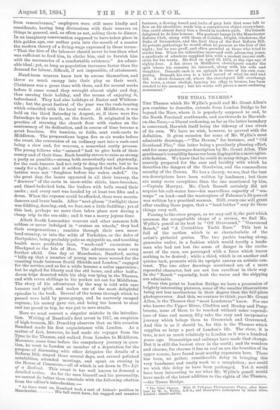THE TIDAL TH AMES THE Thames which Mr. Wyllie's pencil and
Mr. Grant Allen's pen combine to describe, extends from London Bridge to far beyond the Nora, where it is popularly supposed to end, to the North Foreland southwards, and northwards to Harwich- on-the-Naze, —a liberal reckoning, as far as the latter boundary is concerned, Harwich itself being the tideway of two rivers of its own. We have no wish, however, to quarrel with the definition. It gives occasion for some of Mr. Wyllie's most admirable drawings,—" The Downs," for instance, and " Old Southend Pier," this latter being a peculiarly pleasing effort, and for some picturesque description by Mr. Grant Allen. This gentleman's versatility has never been displayed in a more agree- able fashion. We knew that he could do many things, but were scarcely prepared for the ease and lucidity with which he describes the dangers of the Goodwins, and the commodious security of the Downs. He has a theory, we see, that the best sea-descriptions have been written by landsmen ; but there are many more exceptions than the one mentioned by him, —Captain Marryat. Mr. Clark Russell certainly did not acquire his salt-water lore—his marvellous capacity of " sea- scape " on land—and the masterpiece of Falconer's Shipwreck was written by a practical seaman, Still, every one will grant after reading these pages, that a " land-lubber " may do these things very well. Passing to the river proper, as we may call it, the part which assumes the recognisable shape of a stream, we find Mr. Wyllie's pencil at its best in "Off Gravesend," Gravesend Reach," and " I Corinthian Yacht Race." This last is full of the motion which is so characteristic of the artist's pictorial genius. The two yachts tearing along, gunwales under, in a fashion which would terrify a lands- man who had not lost the sense of danger in the excite- ment of the race, are portrayed with a force which leaves nothing to be desired ; while a third, which is on another and quieter tack, presents with its upright canvas an artistic con- trast. The two other drawings mentioned are of a more reposeful character, but are not less excellent in their way. In the " Reach " especially, both the water and the shipping are admirable.
From this point to London Bridge we have a procession of brightly interesting pictures, some of the smaller illustrations being not less meritorious in their degree than the full-plate photogravures. And this, we venture to think, pace Mr. Grant Allen, is the Thames that "most Londoners" know. For one who knows the Upper River, Cliefden and Henley and Pang. bourne, none of them to be reached without some expendi- ture of time and money, fifty take the easy and inexpensive journey which brings them to Greenwich and Gravesend. And this is as it should be, for this is the Thames which supplies so large a part of London's life. The river, it is true, is not as much relatively to London as it was a hundred years ago. Steamships and railways have made that change. But it is still the busiest river in the world ; and its wonders and charms, for charms it has as real as are the beauties of its upper course, have found most worthy exponents here. There has been, we gather, considerable delay in bringing this very handsome and costly work to a completion ; nor could we wish this delay to have been prolonged. Yet it would have been interesting to see what Mr. Wyllie's pencil would have made of the latest addition to the sights of the Thames, —the Tower Bridge.
• The Tidal Thames. With 20 Full.pago Photogravure Plates, after Draw- Inge by W. L. Wyllie, A.B. A., and Dosoriptive Letterpress by Grant Allen. Loudon Owen and Clo.


































 Previous page
Previous page